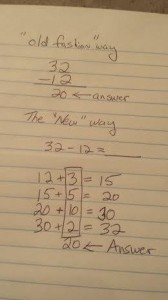 Memes are everywhere about common core. And they NEVER tell the full story.
Memes are everywhere about common core. And they NEVER tell the full story.
These photos on the internet are showing a snapshot in time, and asking old people to make a snap judgement on it. This is new?! What is this?? How are kids supposed to learn?! This is stupid!!!
No it’s not. There are two reasons this is not new.
1st way to know this is not new. I learned this exact method in 1988. We called it “count-up subtraction.” I don’t necessarily remember doing it in as many steps as this example- but that is EXACTLY what this is: One of many methods of doing subtraction in your head- as described on paper. Any method you want to teach needs to be explained out on paper- and tested at some point. Just because a student can come up with the right answer doesn’t mean they know why. Maybe they have memorized flash cards (which I totally support… but I never had a flash card that was 1,452 – 766) – so learning other methods are important, along with showing the understanding and execution of that method.
And that’s exactly what “the new way” (which IS NOT new) is above. Most likely- the teacher explained it as they went.
Hey kids- you already know how to write 32-12, with the thirty-two above the twelve, and then subtract them just one place at a time. You’ve also learned how to “borrow” to avoid negative answers when doing the ones-place column. Now I’m going to teach you a way to do the same math problem in your head, without pencil and paper. There are times that you simply won’t have them available- and many people find this method to be a good alternative. Once you have proven proficiency with this method- you can choose which one to use in the future for whatever circumstance you find yourself in.
So! Here is how we COUNT UP. Start with the number that’s being subtracted… twelve… and count up to the larger number. This will give you the number of digits between the two numbers, and that will be the same answer you’ll come up with conventional pencil and paper. To make it easier than just counting on your fingers (since we already know the answer is 20, and you don’t have 20 fingers) I’m going to also show you how to get to easy numbers, and add them at the end. Since you all already have your addition flash cards memorized – this will end up being a very simple addition problem. I know, I know- it’s kind of silly using 32-12 as the example: but we are doing that because it’s already a simple problem- and prove that this method works. We’ll do a harder one next.
Twelve– counting up, becomes fifteen when you add 3. (remember 3) fifteen becomes twenty when you add 5 more. 5 + 3 = 8. (remember 8) Twenty becomes thirty, when you add ten. 10 + 8 = 18. (remember 18) Thirty becomes thirty-two when you count up by just two more. 18 + 2 = 20. And there is your answer.
Now, refer back to the graphic at the beginning, and it should make sense. But if you never learned this- or don’t remember it (because now it’s automatic in your head) – you might not realize what you’re looking at. As I said before, this has more steps than I remember doing it. I would have done twelve to twenty in 8, twenty to thirty-two in 12. 12+8=20 — there’s the answer again!
The 2nd point to prove this isn’t new- because it isn’t REPLACING anything. No one is saying that kids will only do subtraction this way from now on. It’s a method being taught- and I’m personally glad I was exposed to it in the ’80s. That same year, my family moved and I switched schools. That first or second day at the new school, we had a subtraction test. I finished in at least half the time of the rest of the class. They saw me “counting up” on my fingers, and finishing really fast. After, I taught a few kids how to do it- they were amazed.
The way we learn never makes sense in that brief moment in time. Think about kids sounding out new words. Are your kids going to read that way forever? Will each “sil–uh-buh” (syllable) have that hard cadence when your child is 14, and reading Harry Potter books? Nope. It’s just a step along the journey.
Think of it this way- at some point our kids will hopefully be in advanced calculus. They are going to have graphic calculators. When they see 32-12 in the middle of a super complex problem, they might end up typing it into a calculator. And this is ok- because they understand how/why 32-12 = 20. But just because a calculator exists doesn’t mean they should skip the first 10 years of math, where they learn basic counting, flash cards, conventional subtraction (“the old way”) and alternative methods (“the new way”) — if you want your kid to learn any of those methods, but you know that one day they will use a calculator- then you should let them learn all the ways to solve a problem. Not only will some kids find an easier way to do math- but it proves to them that any problem in life can be solved or worked out by taking multiple paths to it.
Finally- I want to address the attitude of, “this isn’t how I learned it” and “it doesn’t make sense to me”
It. Doesn’t. Matter. — This is your child’s education. Not yours. If you want to learn it, and help your child- I’m all for it. But you can’t just give up, and post angry photos on the internet, and remind the world that you’re an engineer- and common core doesn’t make any sense to you. Some kids are bad at spelling. Others will struggle with algebra. We can’t just give up when school work gets hard. There are times that the way our kids learn will seem “childish” — and that might have something to do with the fact that they are children. When a child has 10 marbles, and you have them move 3 away, and recount the rest- they come up with the answer 7. Just because you’re teaching that way doesn’t mean I’m going to post photos of marbles on Facebook, and demand to know how you expect kids to do math if they don’t have marbles! It’d be as true as these memes though- because it’s a snapshot in time about how someone is learning math.
Now- the complex problem, using what this meme calls “common core.” Remember- I am typing out exactly what I do in my brain. This will read as a long and drawn out way to come up with an answer– but it’s an answer I can come up with when there is no calculator. It’s one that I can come up with when I don’t have paper and pencil. It’s one I can come up with while driving a car.
1,452 – 766
OK- I’m going to count up. I know (from flash cards) that 100-66 is 34. So 766 counting up to 800 is 34. (Remember 34) Now, 800 to 1400 is the same as 8 to 14, with some hundreds on the back end. I know that 8 counting up to 14 is 6 (for you can mix it up and use flashcards to do 14-8=6) so for this section, we have 600. 600+34 is 634. (remember 634) Alright! If we’re at 1400… only 52 to go. We should now be able to add the last 52 directly to the 634. I can mentally stack them in my brain and then I know that 2+4=6 (and no need to carry, good!) and that 5+3=8. So we have 686 as the final answer.
As I typed that, I realized that I actually used flash card memorization, COUNTING UP (“new common core” myth), and CONVENTIONAL addition at the end. I merged 3 different methods to come up with the quickest answer available, that’s accurate, and required no pencil/paper, calculator, or reliance on just one method.

Good explanation of a complicated subject. While I thi “down deep ” I un your point, I just see 25 steps to get to the answer.
I haven’t tried it, and shouldn’t ban it if I have tried it. But I stru with “why is this better “?
It’s not better. It’s different.
It is in no way a “mandate” — like all the memes make people think it is- “new math” implies that an “old math” has been sent out to pasture… and we’ll never use paper and pencil again.
Again, think of it this way- do you have a negative reaction to kids using calculators? Because doing so doesn’t mean they’ll never know (and haven’t already learned) the “old math” ways of doing basic math problems…